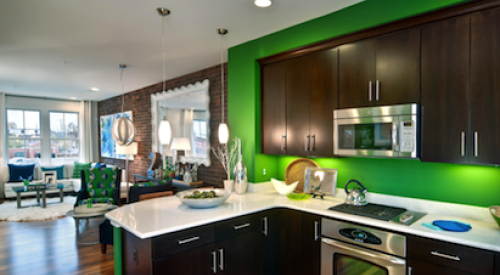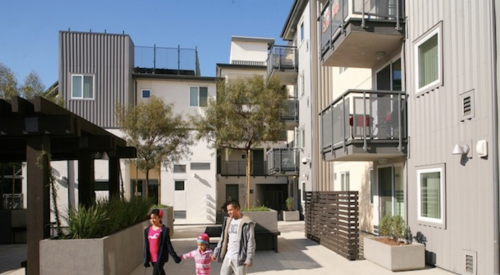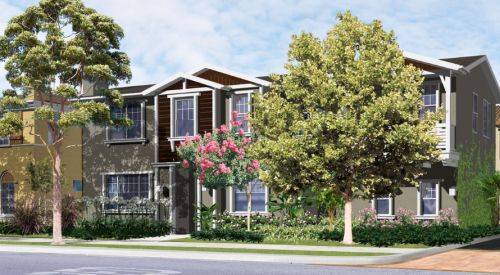|
With the cost of land climbing and resistance to suburban sprawl mounting in some areas, GIANTS are looking for alternatives to business as usual, seeking options that will help them achieve and maintain the growth Wall Street expects.
Large builders are taking on infill projects — brownfields as well as land skipped over in previous developments — that are more indigenous to smaller, niche builders. They are using them as a way to reach a different buyer segment, achieve higher margins and thrive in an arena of less competition.
 |
Atlanta is a very good market — often competing with Phoenix for the highest number of housing permits issued, according to Schulmeyer. "When you invest in a product like infill, for which the competition isn't as direct, you gain some market advantage," he says.
"There is less resistance to doing infill than there is to doing traditional greenfield building," says Douglas Fenichel, regional director of public relations and communications at K. Hovnanian. "In places like New Jersey, and more and more in other states, regulations are actually making it very difficult to do any kind of traditional greenfield building, and [that's] pushing us back into the cities."
"Builders in general are fleeing to cities you've never heard of on the outskirts of town," says GIANTS contributor John Burns, president of John Burns Real Estate Consulting. "Some of that is okay, but you don't want to have all of your assets an hour from the job centers. Some of them are looking for diversification."
Finding the right mixGIANTS have varying philosophies and practices regarding how much of their production is, or should be, devoted to infill. In many instances, the market a particular builder serves determines the ratio.
"You have to look at it by geography," says Burns. "I'm sure it's going to be a very small part of their business nationally. You are not going to build much of this in Las Vegas, Phoenix and Texas, where they have a lot of their volume. But . . . it could easily be 40 to 50 percent of their volume in California, or some places that have major urban areas where there is a lot of demand for this. You'll have some divisions that will focus on it, and some will ignore it altogether."
"You can't build a business around infill, because the opportunities are too inconsistent and you just don't know when they're coming," says Peter Simons, senior division president for Beazer Homes' Colorado division. "If you have your mainline business with your long-term, greenfield projects [and] one of these comes along, then it's a great opportunity to spike your business plan in a given year by selling a bunch of high margin units that typically sell very fast, because there's not much product out there."
"It will grow first in California — [because of] land value and the scarcity of suburban or greenfield land opportunities," says Alan Boeker, president of the Los Angeles division of Standard-Pacific. "In [terms of] a percentage of all new home sales, [infill is] 30 to 60 percent [here]."
"We've been doing some consulting with our divisions in Florida and Denver," Boeker says. "[In] those markets, the divisions are a little slow to evolve. The extent to [which] they can still find land to do what they're used to doing, and achieve their business plan in more traditional housing forms, that's probably the best thing for them to do."
"We are at about 25 percent of our business, headed to 35 to 40 percent over the next couple of years," says Schulmeyer. "We believe in it strongly here as a great compliment to our business."
However, there are large builders who have, through perseverance and perhaps ingenuity, cultivated a successful, exclusive infill business. Being in the red-hot infill market of California doesn't hurt either.
"We've structured a business around infill," says Steve Olson, president of The Olson Company in Seal Beach, Calif., "which takes a lot of time." Part of the success that we have is the ability to partner with cities and local communities — working with municipal planners, redevelopment agents and elected government officials — turning them into partners and development advocates. We're providing solutions to them, rather than just being somebody that walks in the door with an opportunistic housing project."
"Our primary, if not exclusive business, is some kind of infill," says Joe Head, president of SummerHill Homes of Palo Alto, Calif. "As I understand it, we set out to become an infill builder from the very beginning.
"The pros of infill projects," Head says, "are that they are almost always in a market area that is established, that has enough going on in it so that regardless of the ebbs and flows of the economy on a macro basis, they are still a great community to live in."
Builder bewareDespite the success stories, GIANTS would be wise to take a good look before leaping into infill.
"Urban infill housing is generally pretty expensive to build," says Burns. "The land is usually expensive and the construction costs are quite expensive. You need a market that can support the price that you need to make money. In a lot of the affordable markets around the country, that's difficult to do. [If] you can get a nice house for $200,000, those markets don't usually have a lot of urban infill opportunities, because who's going to buy a condo in town for $250,000?"
"You need to do an analysis from a zoning standpoint as to density and how many units you're going to get," Simons says. "Because if you go through all this brain damage and at the end of the day you're approved for 10 units — if you're a big production builder, that's not going to make sense. It might for a little guy. That is why you typically see smaller developers and builders doing this stuff, because they don't have a lot of overhead. They don't have Wall Street to respond to on their growth. They just need to find a good project that's going to make them money. For us, we need to have it fit into our business plan.
"To make it worthwhile, it ought to be your most profitable part of your business," adds Simons. "It won't be [in terms of] the number of units, it won't be [in terms of] the number of dollars, but as far as your margins — you ought to have your best margins in your company with infill projects for sure."
Not business as usualGIANTS have discovered that infill building, to some degree, requires a different skill set.
"They've found that it's a very specialized business," Burns says. "They've had to hire additional management or additional expertise to do this. It requires a different subcontractor base and a different project management skill."
"We decided to bring all the expertise in-house," says Tom Noon, COO of the California division of D.R. Horton. "We call it our urban division. It doesn't go out and find the projects. But it serves the purpose of a general contractor — from value engineering in the beginning, to plant checking the architect's plans, to delivering the finished unit to the buyer."
Standard-Pacific's Los Angeles office functions in part as a company wide resource on infill.
"Other than expanding the company's brand presence and business in Los Angeles," says Boeker, "we gather and offer best management practices associated with higher density housing and then share those with the other operating divisions for them to use as is appropriate in their markets."
 |
"With an infill," Simons says, "you're surrounded by people who may have lived there for 30 years, and they kind of like that abandoned lot down the street. You really have to do extensive due diligence, much more than a greenfield site, so you know what you're getting into, and you can quantify in terms of both time and dollars what it's going to take to get your product across the finish line — or even to get it to the starting blocks."
"You need to fit in," says Head. "You have a variety of neighbors who are anxious about what it is you will be and how you will interrelate with them. That could be residential neighbors not wanting to have their traffic and densities increase, or it could be commercial neighbors that don't want to have their activities negatively impacted."
"You need diversity of product," says Fenichel. "If all you're used to building is a 3,000 square foot colonial-style home, no matter how much you mush it, put it on its side, or stomp on it, it may not fit into an urban setting or into a first ring suburb setting. You need to be able to have the products in your portfolio that will fit."
More challengesInfill projects generally require a larger investment of time and money. But this is where GIANTS generally have an advantage.
"They, by and large, have very strong balance sheets," says Burns. "With a typical subdivision, you're able to phase it and build ten units at a time. On these, you might be building 100 units at a time, because it's a large building with 100 people. You'll frequently have $50 million or $100 million invested in this property. You can't get any of the cash back until the whole thing is complete, because no one can move in until the whole building is finished. It puts a lot a strain on the balance sheet, but the GIANT builders can handle that easily. A lot of the small guys can't."
"There's a lengthier approval time," says Schulmeyer. "But we go in early. Instead of walking in and saying, "This is our product," we walk in with the city and say, "What would you like to see?" and then try to combine it with, "This is what we had in mind." So we work through that process, which is longer."
"The home building industry today is very internal-rate-of-return driven," says Olson. "Land is inventory, and maximizing inventory returns and being good builders — having homebuyers cued up and closing that whole cycle as quickly as you can — can maximize your returns. With infill, because you are dealing with long-range entitlement issues and you are dealing with trades that, in many cases, are different from what you would have with a traditional kind of greenfield housing project, you end up with a lot of different challenges."
Finally, it is important that builders recognize who their infill buyers are, because, in many cases, they are not the same buyers to whom they sell production homes.
"You're not generally selling to families," says Burns. "You're selling to singles, couples without kids, empty nesters and retirees. We've been doing a lot of psychographic demand research to help [builders] understand who these buyers are."
Knowledge is powerThe best way for builders to determine whether infill is right for them is to do their homework.
"The pot of gold at the end of the rainbow on these projects needs to be really good sales prices and really good margins," says Simons. Do your market research. One of the benefits of infill sites often is you've got a very mature population there that's built up a lot of equity in their homes, but they don't want to move out to the suburbs to buy a bigger or newer house. So you can provide some cool product that they have money to spend on, and have an opportunity to buy something in the neighborhood they like living in. You can do an analysis based on your psychographic and demographic information on the population [living] there."
"[Infill] may not be [among] your high volume projects, but if you get a reasonable number of units in a reasonable period of time and make great margins on them, then they can fit in, and they can be your most successful projects."
|












